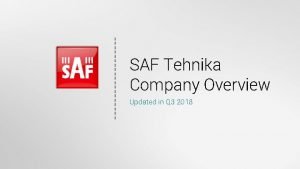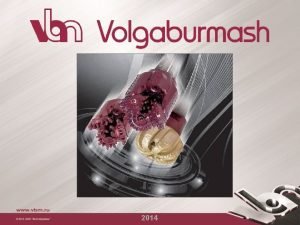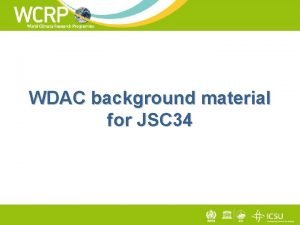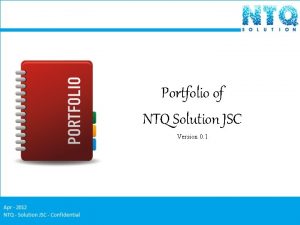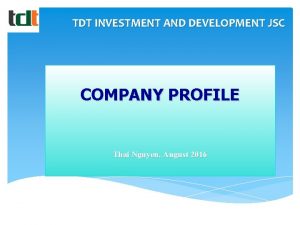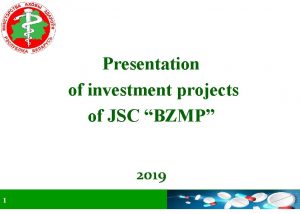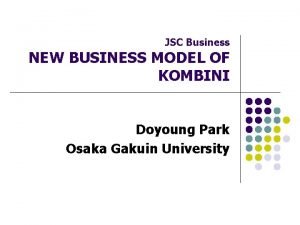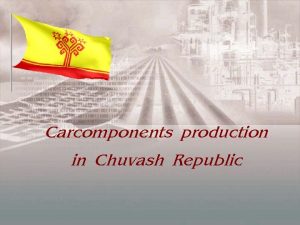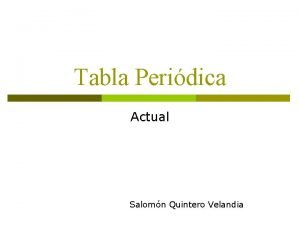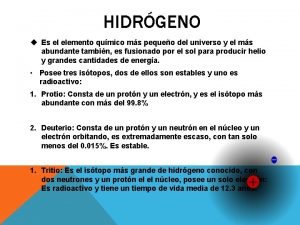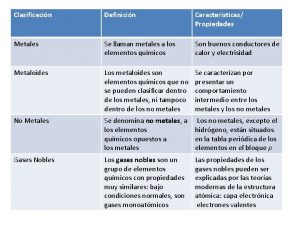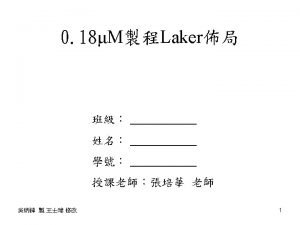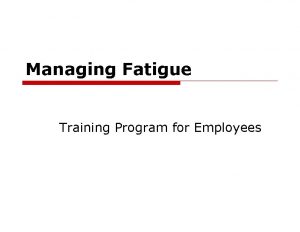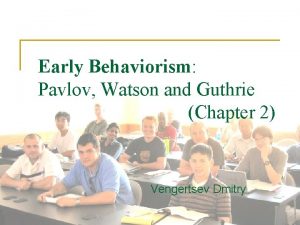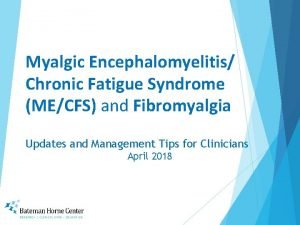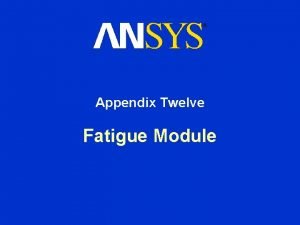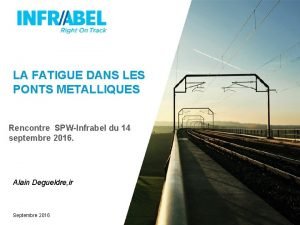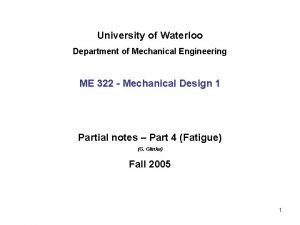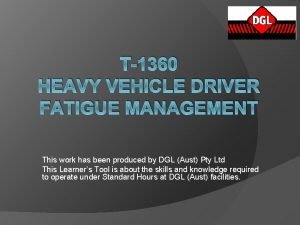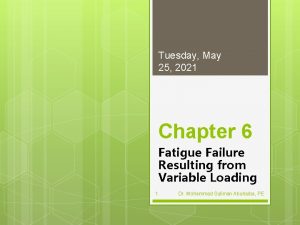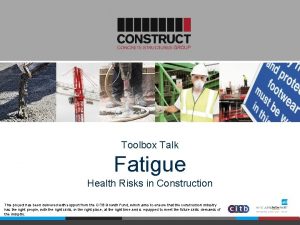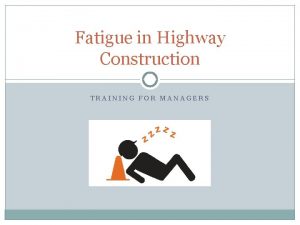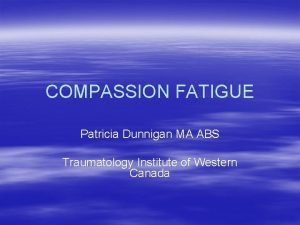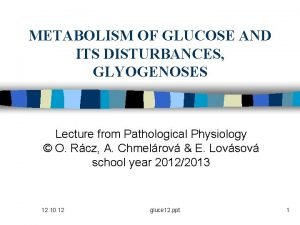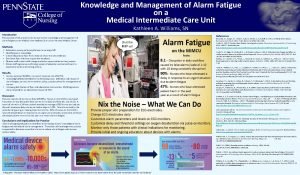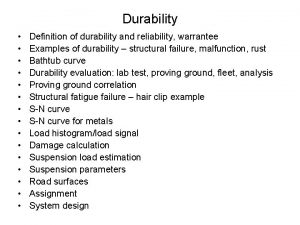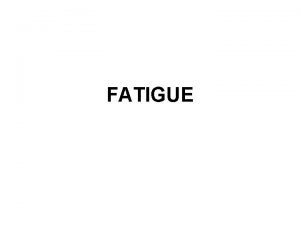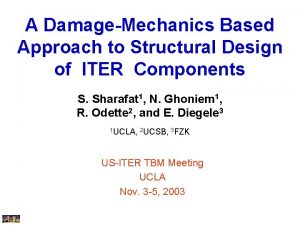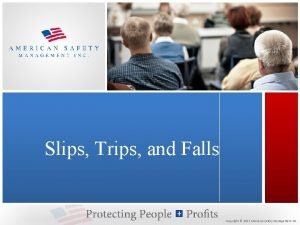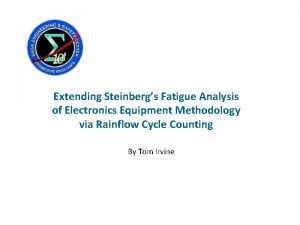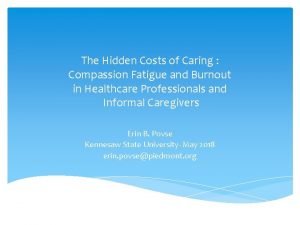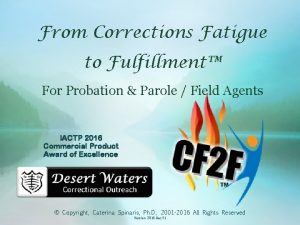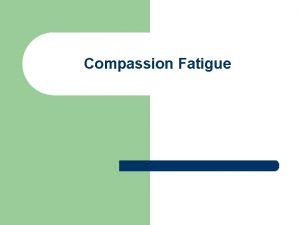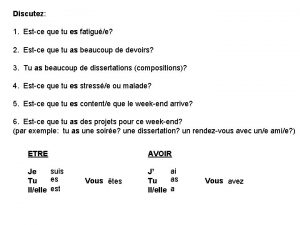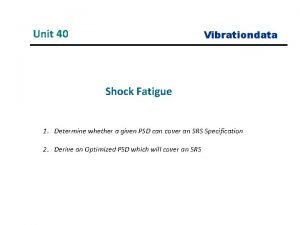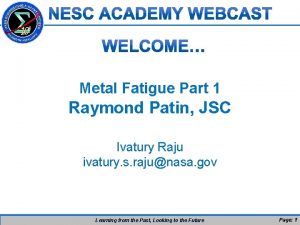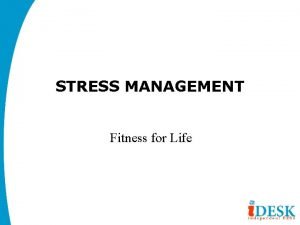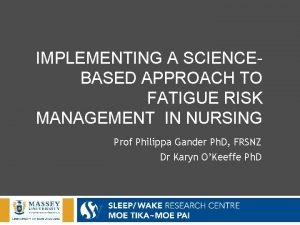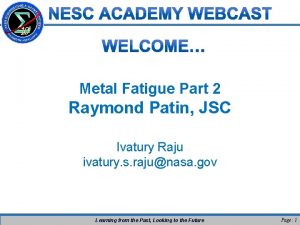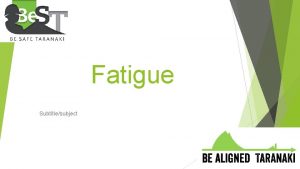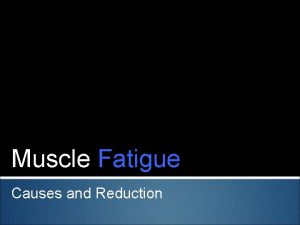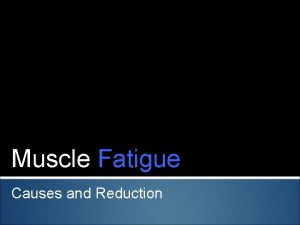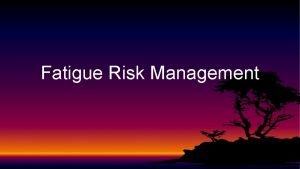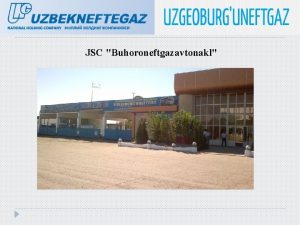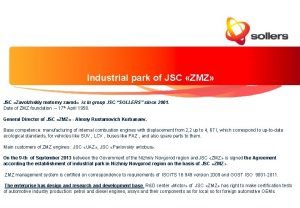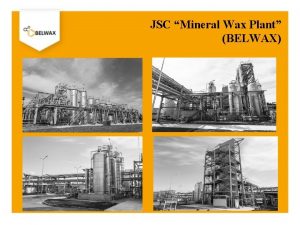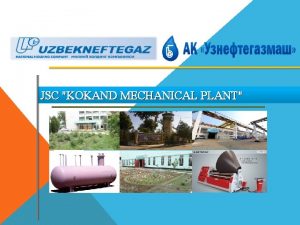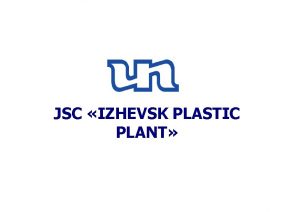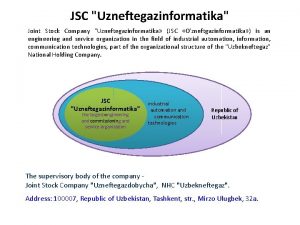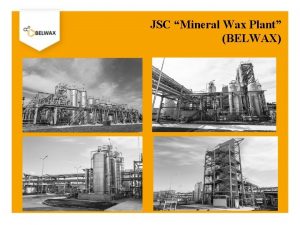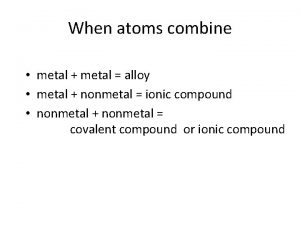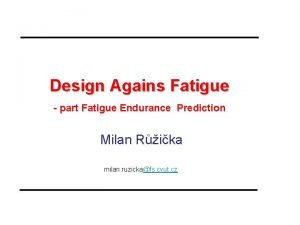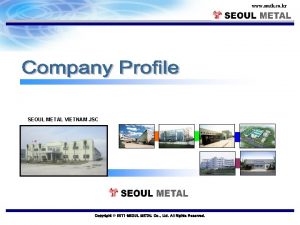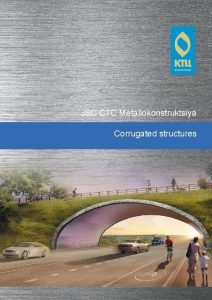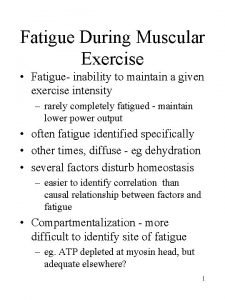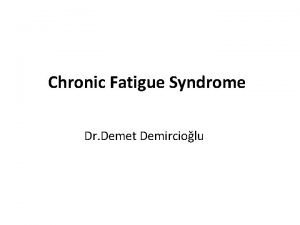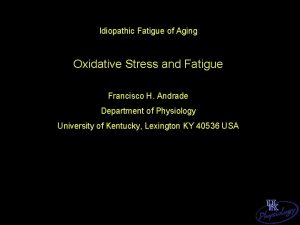Metal Fatigue Part 1 Raymond Patin JSC Ivatury



























































- Slides: 59

Metal Fatigue Part 1 Raymond Patin, JSC Ivatury Raju ivatury. s. raju@nasa. gov Learning from the Past, Looking to the Future Page: 1

SLa. MS Webcast Series Learning from the Past, Looking to the Future

Metal Fatigue a cursory overview by Raymond Patin NASA/JSC

Subject Outline • Introduction – Definition & Historical Overview • The S-N Curve • The S-N Endurance Limit • S-N Fatigue Scatter • Torsion Fatigue • Mechanics of Fatigue Damage Accumulation • Fatigue Failure Fracture Surface Features • Strain-Life • Linear Elastic Fracture Mechanics • Fatigue Life Example Problem 4

Introduction 5

Structural integrity is a multi-disciplinary endeavor with the objective of preventing catastrophic failures within the operational life of the hardware. Structural integrity is assured via the imposed static strength and service life (fracture control) requirements. Static Strength The static strength requirement assures the load carrying capacity of the structure for a single load cycle up to a prescribed maximum load magnitude (limit-load x factor of safety). Static strength verification testing can be performed at various stages (component level, subassembly level, and/or fully integrated assembly) with the inherent assumption that nominal material and build tolerances are captured within the test article. The assumption of a ‘nominal material’ applies not only to the static strength properties, but also the initial quality regarding preexisting defects that can alter the failure load capacity of the structure. Thus the static strength test article does not verify or define the load carrying capacity of the structure with initial damage and/or structural damage that will accumulate with usage. Service Life (Fracture Control) The service life (fracture control) requirements address the time based or usage induced damage mechanisms that degrade the structural load capacity and functionality of the structure. Environmental interactions such as corrosion, mechanical load fluctuations, and/or thermal exposure variations interact to degrade and damage the structure and its load carrying capacity as function of service time. The service life discipline must not only define the rate of damage accumulation, it must also define the load carrying capacity of the structure with damage present (residual strength). Service life verification testing is typically performed on an accelerated time scale which may exclude the time based influences and interactions to some degree. The loss of testing based realism in terms of the time scale, environmental exposures, usage deviations, and boundary condition variations is why usage monitoring and periodic inspections are required to verify service life predictions. The objective of the service life requirements is to define a safe interval of operation with multiple intervention opportunities to mitigate a catastrophic failure in service. 6

What is metal fatigue? The definition of "fatigue" according to ASTM* Standard E 1150 reads as follows: “The process of progressive localized permanent structural damage occurring in a material subjected to conditions that produce fluctuating stresses and strains at some point or points and that may culminate in cracks or complete fracture after a sufficient number of fluctuations. ” *ASTM – American Society for Testing and Materials Flow chart description of the metal fatigue process 7

May 8, 1842 – Versailles train crash An axle of the leading locomotive of a double-headed train suddenly failed (departing King Louis Philippe's birthday celebration), causing it to derail resulting in the second locomotive crashing into the first and the wooden carriages piled into the wreckage where they were set alight by the burning locomotives. More than 75 persons died in the accident. During the subsequent debates regarding the accident the term “fatigue” was coined to describe the sudden fracture of a component from repeated stresses which appeared to be performing well up to that point. Axle failure location Rotating beam/bending fatigue crack initiation & propagation Fast fracture region Ref. : R. A. Smith, “Railways: Structure Integrity, Past, Present, and Future”, Chapter 1. 03, Volume 1, Examples and Case Studies, R. O. Ritchie and Y. Murakami, volume editors, part of the 10 -volume set, Comprehensive Structural Integrity, B. Karihaloo, R. O. Ritchie, and I. Milne, overall editors, Elsevier Science Ltd. Oxford, England, 2003. 8

The S-N (stress versus life) Curve 9

The S-N curve : August Wöhler – Rotating Beam Fatigue Testing In the 1850 s and 1860 s August Wöhler performed the first systematic laboratory experiments that demonstrate why repeated stresses in railroad axles were so damaging. The rotating beam fixture imposed fully reversed bending stresses over the entire periphery of the specimens. Wöhler was seeking to define the stress level below which an “indefinite” number of reversals could be sustained without failure – defined today as the “endurance limit”. Wöhler also demonstrated that applied stress range was more important than stress magnitude. Applied torque to rotate specimens (2) moment arm increasing stress concentration Applied Load peak bending stress fully reversed Ref. : S. S. Manson, G. R. Halford, Fatigue and Durability of Structural Materials, ASM International, March 2006, pp. 45 -46. 10

The S-N curve : Rotating Beam Fatigue Testing The linear elastic stress gradient associated with bending results in larger volumes of material being affected as the diameter of the cross section is increased. Larger material volumes at higher cyclic stresses increases the likelihood of microstructural defects being present which adversely impacts fatigue strength. Thus bending fatigue data demonstrates a size effect ; primarily at long lives – less evident in tension fatigue data. Diameter Endurance Limit Ref. : Bannantine, J. , Comer, J. , Handrock, J. , Fundamentals of Metal Fatigue, Prentice-Hall, 1990, pg. 12. 11

The S-N curve : Linear versus Logarithmic The same S-N data results are plotted below on a linear and logarithmic scale for the test defined cycles to failure. The logarithmic scale linearizes the results over a range of applied stress amplitudes. The Basquin power law relation (1910) defines the finite fatigue life in the linear region ; Sa = A(Nf)b S-N data linear region on log scale S-N data linear plot S-N data logarithm plot Ref. : Horace J. Grover, Fatigue of Aircraft Structures, NAVAIR 01 -1 A-13, 1960, pg. 36. 12

Constant Amplitude Cyclic Loading Definition Constant amplitude cyclic loading is typically utilized for the characterization of materials in fatigue testing. The load-time waveform is typically sinusoidal and varies from a fixed minimum to maximum load magnitude at a defined frequency (cycles/second). It is noted that most engineering fatigue applications deviate from this simplified loading scheme since the max/min loads vary throughout (variable amplitude loading). 1 cycle Ref. : Bannantine, J. , Comer, J. , Handrock, J. , Fundamentals of Metal Fatigue, Prentice-Hall, 1990, pp. 5 -6. 13

Stress Ratio Loading Demonstrations Constant amplitude cyclic loading waveforms for various stress ratio levels are provided below relative to a fixed maximum load/stress ; (R = min/ max). Load/Stress 0<R<1 High tensile mean load/stress R=1 Constant load m >> 0 m = 0 Time R=0 Tensile mean load/stress = 0 Full range tension loading m < 0 -1< R < 0 m << 0 Low tensile mean load/stress R < -1 Compressive mean load/stress R = -1 R= R>1 Mean load/stress = 0 Fully reversed loading Zero to minimum Cyclic compression loading 14

Mean Stress Influence on Constant Amplitude Fatigue Life The fatigue life is minimized for increasing applied stress ranges ( ) at a fixed maximum stress level. For a fixed alternating stress ( a) level the resulting fatigue life will generally decrease within increasing mean stress ( m) – applied maximum stress is increasing with increasing mean. R < -1 R = -1 R > -1 Ref. : ASM Handbook, Vol. 11 Failure Analysis & Prevention, Becker, W. T. , and Shipley, R. J. , editors, Fatigue-Life Assessment, Kaplan, M. P. , & Wolff, T. A. , pg. 277, ASM International, 2002. Ref. : Stephens, R. I. , Fatemi, A. , Stephens, R. R. , & Fuchs, H. O. , Metal Fatigue in Engineering, 2 nd ed. , . John Wiley & Sons, 2001, pg 75. 15

Example of Mean/Residual Stress Influence Limitations A tensile overload will reverse yield into compression and conversely a compressive underload will reverse yield into tension (for localized yielding enveloped by a large elastic volume). The remaining fatigue life is greater for the compressive residual/mean stress at lower load levels, but the mean stress influence is neutralized at higher load levels by cyclic plastic straining. Cyclic plastic straining on a per cycle basis removes mean stress influence s tres ile tens ns mea ean em ssiv pre com ss stre Ref. : Morrow, Jo. Dean, Wetzel, R. M. , and Topper, T. H. , “Laboratory Simulation of Structural Fatigue Behavior, ” Effects of Environment and Complex Load History on Fatigue Life, ASTM STP 462, 1970, pp. 74 -91. 16

Constant Life (Haigh ; 1917) Diagrams The S-N fatigue data can be transformed into a constant life diagram as a function of the applied alternating and mean stresses via the test data points at specified cycles to failure. The resulting plot is known as a Haigh diagram (1917) which is used to characterize constant amplitude fatigue data mean stress influences. (max stress) R = -1 R=0 (N ; cycles to failure) R=1 Ref. : Grover, H. J. , Bishop, S. M. , and Jackson, L. R. , NACA TN 2324, March 1951, pp. 51, 64. 17

Master Diagrams The addition of an extra set of axes (maximum & minimum stress) to the constant life (Haigh) diagram results in a master diagram. Me an str ess g tin na ter Al ess str Ref. : Fatigue Data Book : Light Structural Alloys, ASM International, 1995, pg 72. 18

Goodman Diagram (1899) The original Goodman diagram (1899) defined the influence of mean and alternated stresses on the resulting cycles to failure with Wohler’s data with linear projections as a function of material ultimate strength and applied mean and alternating stresses. A subsequent correction (inclusion of endurance limit) to improve agreement with data results in the modified Goodman equation/diagram. modified Goodman diagram Ref. : James O. Smith, Univ. of Illinois Bulletin -The Effect of Range of Stress on the Fatigue Strength of Metals, Vol. XXXIX, Feb. 17, 1942, No. 26, pg. 14, 20. 19

Mean Stress Empirical Relationships The generation of S-N master diagrams is very expensive and time consuming. Empirical relationships that define the infinite life boundary afford a reasonable preliminary design option. These methods result in various curves that connect the alternating stress ( a) and mean stresses ( m) to the endurance limit (Se) and either the material yield (Sy), ultimate (Su), or true fracture stress ( f). Ref. : Bannantine, J. , Comer, J. , Handrock, J. , Fundamentals of Metal Fatigue, Prentice-Hall, 1990, pp. 6 -7. 20

Mean Stress Constant Amplitude Service Life Example Note: analytical result is dependent upon potential endurance limit variations/reductions & material data scatter (scatter factor). scatter factor? Ref. : Bannantine, J. , Comer, J. , Handrock, J. , Fundamentals of Metal Fatigue, Prentice-Hall, 1990, pp. 8 -9. load, size, Kt, surface finish 21

Palmgren-Miner Linear Damage Rule In 1924 Palmgren uses linear damage accumulation to define the cycle life of bearings. In 1945 Miner applies the Palmgren linear damage model to aircraft fatigue. The shortcomings of assuming linear damage accumulation are well known (low-to-high or high-tolow loading sequences ni/Nfi 1) but is still commonly incorporated due to ease of use and overall accuracy with respect to other models. Ref. : R. I. Stephens, A. Fatemi, R. R. Stephens, H. Fuchs, “Metal Fatigue in Engineering, 2 nd ed. , ” John Wiley & Sons, 2000, pp. 275 -276. 22

S-N Fatigue Endurance Limit 23

S-N Endurance Limit Alloys that demonstrate a fatigue endurance limit (cyclic stress levels below which fatigue damage is assumed to not occur) and the mechanisms that can remove or eliminate the endurance limit are provided below. Complex assemblies with relative movement that results in localized wear which degrades the initial surface condition relative to that which defined the endurance limit; e. g. , bolted joints. Ref. : Bannantine, J. , Comer, J. , Handrock, J. , Fundamentals of Metal Fatigue, Prentice-Hall, 1990, pp. 2. 24

S-N Endurance Limit ; (cont) A demonstration of periodic overloads removing the S-N fatigue endurance limit is provided below. Most structural applications deviate from the laboratory defined constant amplitude loading. Removes constant amplitude defined endurance limit. Ref. : Jo. Dean Morrow, J. F. Martin, N. E. Dowling, Local Stress-Strain Approach to Cumulative Fatigue Damage Analysis, UILU-ENG 74 6001, T. &A. M. Report No. 379, 1974, pg 51. 25

S-N Endurance Limit – Gigacycle Fatigue ; (cont) Constant amplitude fatigue testing at ultra high cycles (gigacycles ; 10 9) demonstrates finite life at cycle counts beyond 106. The fatigue damage accumulation also shifts from surface to interior initiations. Ref. : C. Bathias, P. C. Paris, Gigacycle Fatigue in Mechanical Practice, Marcel Dekker, 2205. 26

S-N Fatigue Scatter 27

S-N Material Data Scatter S-N data sets typical include only a few data points at various stress levels. The fatigue crack nucleation and initiation process constitutes the majority of the fatigue life and is highly dependent upon surface finish quality and microstructure. From a deterministic perspective a knockdown factor of 4 applied to the median of the S-N data set is assumed to define the lower bound for a complete S-N data set. Ref. : A. P. Berens, Fatigue Life Scatter Factors in Aircraft Applications, UDR-TR-92 -138, 1992. 28

S-N Material Data Scatter ; (cont) The scatter factor of 4 is only applicable to the linear region of the S-N curve – it not applicable within the asymptotic regions of the data curve (endurance limit and material allowable). This result is confirmed in the results below wherein the variance of the S-N data set is no longer constant and increasing beyond 105 cycles. Linear damage accumulation region where the deterministic scatter factor is applicable. Ref. : R. C. Rice, K. B. Daview, C. E. Jaske, and C. E. Feddersen, Consolidation of Fatigue and Fatigue Crack Propagation Data for Design Use, NASA-CR-2586, 1975, pp. 24 -25. 29

S-N Material Data Scatter ; (cont) The S-N fatigue asymptotic regions wherein the traditional scatter factor on life does not assure the desired level of structural integrity assurance is illustrated below. S-N material data curves asymptotic regimes where the traditional scatter factor on life loses its applicability. Ref. : W. C. Brueggeman, M. Mayer, Jr. , and W. H. Smith, Axial Fatigue Tests at Zero Mean Stress of 24 S-T Aluminum. Alloy Sheet With and Without a Circular Hole, NACA TN 995 1944. 30

S-N Scatter (cont. ) - Full Scale Test Results “It can be seen from this figure that all of the full-scale data presented lie within a comparatively narrow scatter band, considering the fact that the data includes different types of airplanes and components with many types of stress raisers. Full-scale fatigue data from other airplanes have been found to fall within the scatter of the data that are presented. ” Ref. : J. J. Mc. Guigan, Jr. D. F. Bryan, and R. E. Whaley, Fatigue Investigation of Full-Scale Transport Airplane Wings, NACA TN 3190, 1954, pg. 10, 41. 31

Torsion Fatigue 32

Modes of Crack Surface Displacements The 3 basics modes of loading and displacements associated with cracked elastic bodies is presented below. The superposition of these 3 displacement modes is typically sufficient to describe most crack tip deformation/stress fields. Mode I – tensile opening mode ; the crack surfaces are displaced away from each other (symmetric with respect to the x-y and x-z planes. Mode II – in-plane (edge) sliding of the crack faces relative to each other ; symmetric with respect to the x-y plane and skew symmetric with respect to the x-z plane. Mode III – lateral displacement of the crack faces (tearing) ; skew symmetric with respect to the x-y and x-z planes. Ref. : H. Tada, P. Paris, & G. Irwin, The Stress Analysis of Cracks, 2 nd ed. , Del Research Inc, 1985, pg. 1. 2. 33

Torsion Induced Stress Fields Torsion loading (round cross section) will result in maximum shear stresses on the longitudinal and transverse planes with axial stresses on 45 planes. Ref. : ASM Handbook, Vol. 11 Failure Analysis Prevention, J. D. Landes, W. T. Becker, R. S. Shipley, J. Raphael, Stress Analysis and Fracture Mechanics, ASM International, 2002, pg. 467. 34

Torsion Induced Fatigue Cracking Pattern/Modes Torsion loading (round cross section) fatigue cracking pattern is a function of the applied shear stress magnitude. Ref. : G. B. Marquis, D. F. Socie, “Multiaxial Fatigue”, Chapter 4. 09, Volume 1, Examples and Case Studies, R. O. Ritchie and Y. Murakami, volume editors, part of the 10 -volume set, Comprehensive Structural Integrity, B. Karihaloo, R. O. Ritchie, and I. Milne, overall editors, Elsevier Science Ltd. Oxford, England, 2003. 35

Torsion Fatigue Failure Cracking Pattern Examples Transverse reversed torsion fatigue crack Spiral reversed torsion fatigue crack Ref. : Donald J. Wulpi, Understanding How Components Fail, 2 nd edition, ASM International 1999, pp. 158, 160. 36

Torsion Fatigue Data Smooth bar torsion fatigue data for various materials with constant cyclic stress amplitude does not demonstrate the same Goodman trend established for tensile (Mode I) fatigue data. Torsion mean stress does not open/displace the crack flanks in sliding modes. Ref. : James O. Smith, Univ. of Illinois Bulletin -The Effect of Range of Stress on the Fatigue Strength of Metals, Vol. XXXIX, Feb. 17, 1942, No. 26, pg. 18. 37

Torsion Fatigue Data ; (cont. ) Notched bar torsion fatigue data for various materials with constant cyclic stress amplitude does demonstrate a similar Goodman trend established for tensile (Mode I) fatigue data. Ref. : James O. Smith, Univ. of Illinois Bulletin -The Effect of Range of Stress on the Fatigue Strength of Metals, Vol. XXXIX, Feb. 17, 1942, No. 26, pg. 22. Ref. : G. B. Marquis, D. F. Socie, “Multiaxial Fatigue”, Chapter 4. 09, Volume 1, Examples and Case Studies, R. O. Ritchie and Y. Murakami, volume editors, part of the 10 -volume set, Comprehensive Structural Integrity, B. Karihaloo, R. O. Ritchie, and I. Milne, overall editors, Elsevier Science Ltd. Oxford, England, 2003. 38

Mechanics of Fatigue Damage Accumulation 39

Plastic Deformation in Metals The elastic limit of a material defines the stress level below which the strains are reversible (on a global level – measurable on a macroscopic scale). Plastic (irreversible) deformation occurs primarily by slip along crystallographic planes – the slip mechanism is dictated by local shear stresses and crystal defect orientations. Defects and imperfections within the crystalline lattice create slip systems along specific planes and in specific directions along a plane. Dislocations (edge & screw) are line defects that exist in nearly all crystals. Ref. : U. Krupp, Fatigue Crack Propagation in Metals and Alloys, Wiley, 2007. Ref. : A. C. Reardon, Metallurgy for the Non-Metallurgist - 2 nd Ed. , ASM International, 2011. 40

Plastic Deformation in Metals – Monotonic & Cyclic Loading When the resolved shear stress exceeds the critical shear stress on the crystal slip plane local yielding will begin. The slip direction will remain unchanged unless barriers/constraints (e. g. , adjacent grains, test grips) are encountered. Cyclic slip is not reversible (due to defect creation/annihilation) and this results is surface extrusions/intrusions along persistent slip bands on the surface. cyclic plastic strain montonic plastic strain Ref. : V. Levitin, S. Loskutove, Strained Metallic Surfaces, Wiley-VCH, 2009, pg 187. Ref. : R. Hertzberg, Deformation and Fracture Mechanics of Engineering Materials, 3 rd Ed. , John-Wiley, 1989, pg 496. 41

Fatigue Crack Nucleation (Surface) The preferential nucleation of fatigue cracks at the surface is due to ease of plastic deformation at the free surface (as opposed to the interior where there is additional constraint). Fatigue cracks can also nucleate at singularities or discontinuities (e. g. , inclusions, second phase particles, grain boundaries, etc. ) on the surface or in the interior. axial load reversal dislocations Ref. : M. A. Meyers, K. K. Chawla, “Mechanical Behavior of Materials, ” Cambridge University Press, 2009, pp. 725 -729. 42

Micro Crack Initiation/Propagation (Surface) Cyclic loading induced fatigue crack nucleation will result in multiple crack initiation sites within the stress concentration region of the component. The local microstructure and surface conditions strongly influence the resulting localized slip responses and subsequent coalescence into micro cracks. . 10 m = 0. 000394 inches MSFC – microstructurally small fatigue crack 43

Micro Crack Initiation/Propagation (Surface) – (cont. ) Another example of micro crack initiation and propagation is provided below. 10, 500 cycles 15, 000 cycles 10 m = 0. 000394 inches 17, 000 cycles Ref. : Ulrich Krupp, “Fatigue Crack Propagation in Metals and Alloys, ” Wiley-VCH, 2007, pp. 151. 44

Crack Propagation Transition : Mode II (short crack) to Mode I (long crack) The resolved shear stress (mode II) mechanism that dictates the surface crack initiation within slip bands is primarily responsible for the subsequent small crack initiation/propagation. As the micro crack growth extends over several grains the single slip mechanism transitions into a multiple slip response that results in mode I crack propagation response. Ref. : Ulrich Krupp, “Fatigue Crack Propagation in Metals and Alloys, ” Wiley-VCH, 2007, pp. 172, 239. 45

Long Crack Propagation (Mode I) - Striations The Mode I fatigue crack propagation occurs via dislocation movements along multiple slip planes in the vicinity of the crack tip. The irreversible nature of the slip response can result in the formation of microscopically visible steps on the fracture surface known as striations. Detectable striations are not always formed - dependent upon material, environment, and rate of crack propagation. Ref. : V. Kerlins, ASM Handbook Vol. 12 : Fractography, 1987, pg 21. Ref. : Pippan, Zelger, Gach, Bichler, Weinhandl, On the mechanism of fatigue crack propagation in ductile metallic materials, Fatigue & Fracture of Engineering Materials & Structures, 34, 2010, pp. 1 -16. 46

Long Crack Propagation (Mode I) – Striations (cont. ) Within a failure analysis investigation striations can be used to physically quantify aspects of the fatigue crack propagation which in turn can be used to calculate the corresponding structural response states (loading type, loading magnitude, number of cycles, etc. ). Ref. : P. H. De. Vries, K. T. Ruth, D. P. Dennies, Counting on Fatigue : Striations and Their Measure, “J Failure Analysis and Prevention, ” vol. 10, 2000, pp. 123, 130. 47

Fatigue Damage Accumulation Process A schematic representation of the fatigue crack nucleation, initiation, and propagation phases is provided below. Fatigue crack nucleation/initiation at the surface via persistent slip bands. Small crack propagation via Mode II mechanism. Long crack propagation via Mode I mechanism. Ref. : R. I. Stephens, A. Fatemi, R. R. Stephens, H. Fuchs, “Metal Fatigue in Engineering, 2 nd ed. , ” John Wiley & Sons, 2000, pp. 51. 48

S-N curve ; Fatigue Damage Accumulation The cyclic time required to nucleate and initiate a fatigue crack consumes the majority of the overall fatigue life. Crack nucleation initiation cycles crack propagation cycles S-N curve Ref. : W. G. Barrois, Manual of Fatigue of Structures ; Fundamental and Physical Aspects, AGARD-MAN-870, June 1970, pg 227. 49

S-N curve ; Fatigue Damage Accumulation (cont. ) The fatigue damage accumulation trend in terms of physical crack measurements with specialized equipment for various alloys is provided below. ~ durability EIFS ~ NDE detection NDE – non-destructive evaluation. EIFS – equivalent initial flaw size Ref. : S. J. Klima, D. J. Lesco, and J. C. Freche, Ultrasonic Technique for Detection and Measurement of Fatigue Cracks, NASA TN D-3007, 1965, pg 13. 50

S-N curve ; Fatigue Damage Accumulation (cont. ) The fatigue test results from full scale structure testing demonstrates the same trend observed at the coupon level. average crack initiation average crack propagation Ref. : R. E. Whaley, Fatigue Investigation of Full-Scale Transport Airplane Wings, NACA TN 4132, 1957, pg 42. 51

Fatigue Failure Fracture Surface Features 52

Fatigue Failure Induced Surface Features The information associated with a fracture surface (macroscopic and microscopic) typically affords useful details regarding the fundamental cause of the failure. Ref. : ASM Handbook, Vol. 11 Failure Analysis Prevention, R. A. Lund, Fatigue Fracture Appearances, ASM International, 2002, pg. 627. 53

Fatigue Failure Induced Surface Features (cont. ) Macroscopic view of T-section fatigue failure. Ref. : P. H. De. Vries, K. T. Ruth, D. P. Dennies, Counting on Fatigue : Striations and Their Measure, “J Failure Analysis and Prevention, ” vol. 10, 2000, pg. 131. 54

Fatigue Failure Induced Surface Features (cont. ) Torsion fatigue in root of grooved bar. Fatigue crack initiation occurs on the surface via Mode III and Mode I propagation occurs in the circumferential direction (downhill) not radially. Mode III initiation Mode I propagation Ref. : K. Tanaka, Small Crack Propagation in Multiaxial Notch Fatigue, pg 40, www. gruppofrattura. it/pdf/cp/CP 2012005. pdf. 55

neutral axis Ref. : ASM Handbook, Vol. 11 Failure Analysis Prevention, R. A. Lund, Fatigue Fracture Appearances, ASM International, 2002, pg. 632. Fatigue Failure Fracture Surface Features (cont. ) 56

neutral axis Ref. : ASM Handbook, Vol. 12 Fractography, G. F. Vander Voort, Visual Examination and Light Microscopy, ASM International, 1987, pg. 119. Fatigue Failure Fracture Surface Features (cont. ) 57

Questions? ? ? To Be Continued…. Learning from the Past, Looking to the Future Page: 58

Metal Fatigue Part 2 June 7, 1 PM ET Raymond Patin Learning from the Past, Looking to the Future Page: 59
 Confederacion argentina de patin
Confederacion argentina de patin Civics 360
Civics 360 Jsc systems
Jsc systems Saf tehnika jsc
Saf tehnika jsc Volgaburmash jsc
Volgaburmash jsc Jsc 34
Jsc 34 Workplace inovations trainings
Workplace inovations trainings Ntq solution
Ntq solution Npls
Npls Tdt investment and development joint stock company
Tdt investment and development joint stock company Www.eol.jsc.nasa gov
Www.eol.jsc.nasa gov Maz trucks
Maz trucks Jsc bzmp
Jsc bzmp Lll
Lll Jsc' elara
Jsc' elara Metal no metal y metaloide tabla periodica
Metal no metal y metaloide tabla periodica Metals vs nonmetals vs metalloids
Metals vs nonmetals vs metalloids El sodio es metal o no metal
El sodio es metal o no metal Metal and non metal difference between
Metal and non metal difference between Spraggins fitness
Spraggins fitness Dp periodic table
Dp periodic table Pure substance periodic table
Pure substance periodic table Metales y no metales
Metales y no metales Melting point of diamond
Melting point of diamond Metals react with nonmetals to form ionic compounds by
Metals react with nonmetals to form ionic compounds by Conduction convection radiation venn diagram
Conduction convection radiation venn diagram Non metal examples
Non metal examples Deep nwell
Deep nwell Metal forming part factories
Metal forming part factories Employee fatigue training
Employee fatigue training Qqqnn
Qqqnn Myalgic encephalomyelitis
Myalgic encephalomyelitis Fatigue tool ansys
Fatigue tool ansys Fatigue
Fatigue Fatigue stress
Fatigue stress National driver work diary daily sheet
National driver work diary daily sheet Gerber equation fatigue
Gerber equation fatigue Toolbox talk fatigue
Toolbox talk fatigue Compassion fatigue definition
Compassion fatigue definition On-site manager fatigue workshop
On-site manager fatigue workshop Abs fatigue
Abs fatigue Muscle fatigue
Muscle fatigue Alarm fatigue definition
Alarm fatigue definition What is fatigue failure
What is fatigue failure Beach marks fracture
Beach marks fracture Thermo-mechanical fatigue
Thermo-mechanical fatigue Fatigue
Fatigue Age fatigue inattentiveness eyesight and footwear are
Age fatigue inattentiveness eyesight and footwear are Steinberg fatigue
Steinberg fatigue Cost of caregiving
Cost of caregiving Corrections fatigue
Corrections fatigue Max ehrmann go placidly
Max ehrmann go placidly Powerpoint template
Powerpoint template Slides fatigue test
Slides fatigue test Tu est fatigue
Tu est fatigue System shock fatigue
System shock fatigue What is the cause of fatigue for the alactacid system
What is the cause of fatigue for the alactacid system Fatigue
Fatigue Objective of stress management
Objective of stress management Fatigue risk assessment matrix
Fatigue risk assessment matrix



